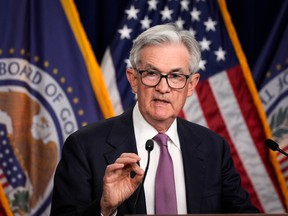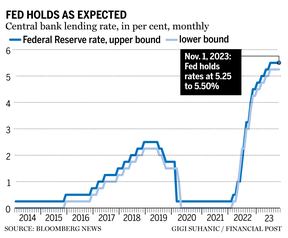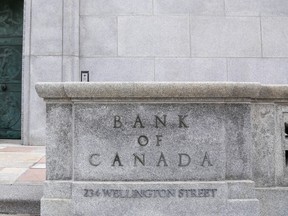New statement noted recent tumult in financial markets has sent longer-term interest rates up to near 16-year highs

Article content
WASHINGTON — The United States Federal Reserve kept its key short-term interest rate unchanged Nov. 1 for a second straight time but left the door open to further rate hikes if inflation pressures should accelerate in the months ahead.
The Fed said in a statement after its latest meeting that it would keep its benchmark rate at about 5.4 per cent, its highest level in 22 years. Since launching the most aggressive series of rate hikes in four decades in March 2022 to fight inflation, the Fed has pulled back and has now raised rates only once since May.
Article content

The new statement noted that recent tumult in the financial markets has sent longer-term interest rates up to near 16-year highs and contributed to higher borrowing rates across the economy.
“Tighter financial and credit conditions for households and businesses,” it said, “are likely to weigh on economic activity.”
Advertisement 2
Article content
That reference echoed recent comments by Fed officials that higher yields — or interest rates — on the 10-year Treasury note could impose a dampening impact on the economy, cool inflation and substitute for an additional rate hike by the Fed.
Long-term Treasury yields have soared since July, the last time the Fed raised rates, swelling the costs of auto loans, credit card borrowing and many forms of business loans. Nationally, the average long-term fixed mortgage rate is nearing eight per cent, its highest level in 23 years.
Economists at Wall Street banks have estimated that sharp losses in the stock market and higher bond yields could have a depressive effect on the economy equal to the impact of three or four quarter-point rate hikes by the Fed.
Those tighter credit conditions, though, have yet to cool the economy or slow hiring as much as the Fed had expected. Growth soared at a 4.9 per cent annual pace in the July-September quarter, powered by robust consumer spending, and hiring in September was strong. On Wednesday, the government said employers posted a sizable 9.6 million job openings last month, well below the peak of early last year but still sharply above pre-pandemic levels.
Article content
Advertisement 3
Article content
Consumer inflation has dropped from a year-over-year peak of 9.1 per cent in June 2022 to 3.7 per cent last month. But recent data suggests that inflation remains persistently above the Fed’s two per cent target.
Chair Jerome Powell and other Fed officials have responded to the surprising evidence of economic strength by saying the Fed will monitor incoming data for any hints that inflation will either further subside or remain chronically above its target level. In the meantime, most Fed watchers expect the central bank to keep rates unchanged in December as well.
Market analysts say an array of factors have combined to force up long-term Treasury yields and couple with the Fed’s short-term rate hikes to make borrowing costlier for consumers and businesses. For one thing, the government is expected to sell potentially trillions of dollars more in bonds in the coming years to finance huge budget deficits even as the Fed is shrinking its holdings of bonds. As a result, higher Treasury rates may be needed to attract more buyers.
And with the future path of rates murkier than usual, investors are demanding higher yields in return for the greater risk of holding longer-term bonds.
Advertisement 4
Article content
What’s important for the Fed is that the yield on the 10-year Treasury has continued to zoom higher even without rate hikes by the central bank. That suggests that Treasury yields may stay high even if the Fed keeps its own benchmark rate on hold, helping keep a lid on economic growth and inflation.
Other major central banks have also been dialling back their rates hikes with their inflation measures having appeared to improve. The European Central Bank kept its benchmark rate unchanged last week, and last month inflation in the 20 countries that use the euro fell to 2.9 per cent, its lowest level in more than two years.
Related Stories
-

Canadians likely to wait until next summer for rate cut
-

What the economists say about GDP
The Bank of England also kept its key rate unchanged in September. The Bank of Japan, meanwhile, is inching toward higher borrowing costs, as it loosens control on longer-term rates.
Article content
Federal Reserve leaves key rate unchanged, keeps future hike on table
2023-11-01 06:14:48






Comments
Postmedia is committed to maintaining a lively but civil forum for discussion and encourage all readers to share their views on our articles. Comments may take up to an hour for moderation before appearing on the site. We ask you to keep your comments relevant and respectful. We have enabled email notifications—you will now receive an email if you receive a reply to your comment, there is an update to a comment thread you follow or if a user you follow comments. Visit our Community Guidelines for more information and details on how to adjust your email settings.